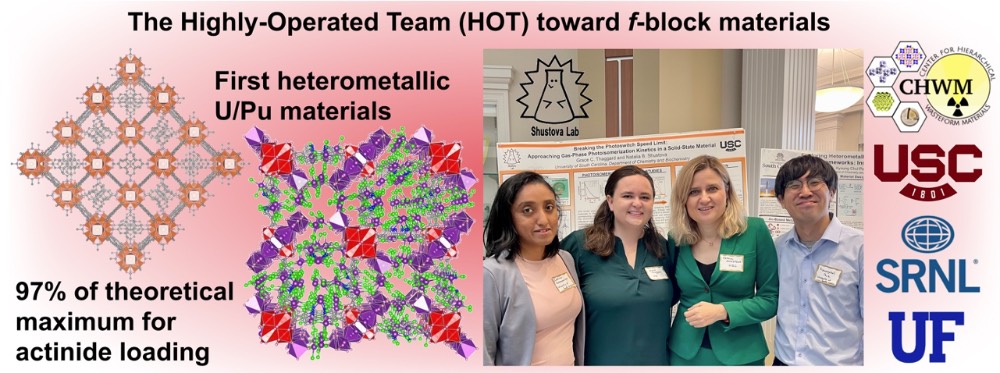
The development of hierarchical waste form materials was prompted by the urgent societal needs for efficient nuclear waste administration that requires innovative solutions. The Center for Hierarchical Waste Form Materials (CHWM), located at the University of South Carolina, was funded by the USA Department of Energy to establish and understand the structure-property relationship in hierarchical extended metal-organic and inorganic structures necessary to advance nuclear waste separation, storage, sequestration and sensing.
Recently the Shustova group, in collaboration with multidisciplinary research teams from Savannah River National Laboratory, Clemson University, University of Florida and Chulalongkorn University, revealed a novel synthetic pathway toward the preparation of transuranic heterometallic extended metal-organic materials: “f-block MOFs: A Pathway to Heterometallic Transuranics” (Angew. Chem. Int. Ed. 2023, 62, e202216349). Besides fundamental understanding, these studies on f-block metal-organic frameworks (MOFs) have been driven by industrial sector demands including nuclear waste administration and potential material applications as radioisotope thermoelectric generators or metalloradiopharmaceuticals.
Currently, most studies on f-block MOFs focus on structural analysis, while studies toward material properties have only recently emerged. The efforts of the Shustova group in collaboration with the researchers from the EFRC center resulted in the development of a unique series of heterometallic f-block-frameworks, which includes the first examples of highly radioactive transuranic heterometallic 238U/239Pu-MOFs as well as a monometallic 239Pu-analog. With collaborators in the research center, Shustova group was able to study the kinetics and thermodynamics of heterometallic f-block materials, providing the first fundamental mechanistic insights on their formation.
Furthermore, 97% of the theoretical maximum capacity has been achieved for radionuclides loading within the porous matrices, leading to the material with the highest actinide wt% for the smallest reciprocal structural density,1/d, foreshadowing a unique pathway for radionuclide sorbents. These discoveries make a significant contribution to the understanding of fundamental aspects of actinide chemistry and offer potential avenues for developing emerging classes of extended transuranic materials, which can shift the paradigm in the nuclear waste administration sector.